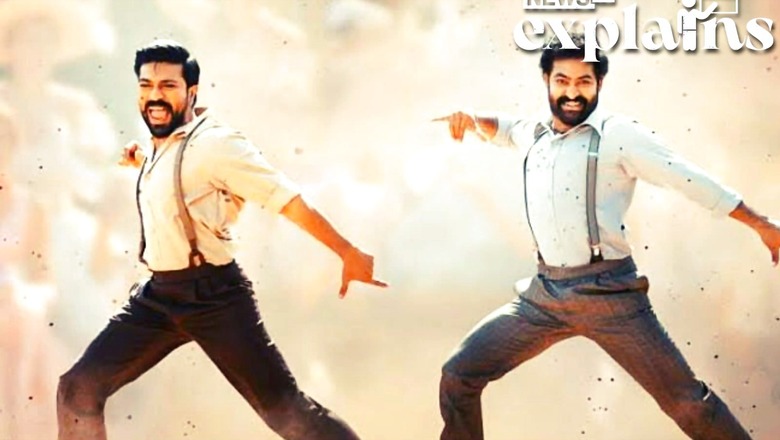
views
‘Naatu Naatu’, the peppy, foot-tapping chartbuster from SS Rajamouli’s Telugu period action film “RRR”, waltzed its way to history by becoming the first Indian track to win the Academy Award in the Best Original Song category.
‘Naatu Naatu’, or “Naacho Naacho” in Hindi, is composed by MM Keeravaani and penned by Chandrabose.
“I grew up listening to The Carpenters and now here I am with the Oscars. There was only one wish on my mind, so was Rajamouli’s and our families — ‘RRR’ has to win, the Pride of every Indian must put me on the top of the world,” Keeravani said in tune to The Carpenters much loved 1970s song ‘Top of the World’. LIVE Updates
This is the third major international recognition for the Telugu song after Golden Globe and Critics Choice Award wins. The film’s team described the win as a ‘surreal moment’.
But amidst so many accolades for the song, it’s worth taking a look at why and how Naatu Naatu captured the fancy of the west. News18 Explains:
How Did Naatu Naatu Capture the Western World?
The song found a ‘vociferous cheerleading squad’ in the US, a report by Variety explained. But how did this happen? There are multiple reasons why.
Naatu Naatu tiktok challenge accepted!! pic.twitter.com/JejUoWewVg— ☀ stevie wong ☀ (@wongie1) January 11, 2023
The “RRR” filmmaking team owes TikTok not only for the song’s global popularity, but also for how homemade clips set to “Naatu Naatu” propelled the film’s US domestic box-office success right out of the gate, the report explained. TikTok users had latched onto a short clip of lead actors Ram Charan and N. T. Rama Rao Jr. performing the peculiar dance step that characterises the choreography and attempting their own versions of it long before the film’s theatrical release.
“When I envisioned the ‘Naatu Naatu’ song, while both of them (the actors) are great dancers, I didn’t want the steps to be so complicated that people can’t do it. It should be like any two people — whether it be friends, mother and daughter, father and son, two brothers or two sisters — would see it and feel like, ‘Let’s try this.’ And they did; millions and millions of people were trying to do the steps and posting on it. It became such a big phenomenon when we released the song, and it clearly (increased) public interest in the film,” ” director S. S. Rajamouli told the Variety.
Keeravani also attributes the popularity to the beat, which is so fast that, like videography of hummingbird wings, you almost have to slow it down to recognise it, the report says.
He told the publication that the beat was 6/8, which was not very common in the West, but more common in India and sometimes in Africa and some other countries.
He said the beat was more South Indian than North Indian. And in ‘Naatu Naatu,’ this beat took on a new dimension and BPM (beats per minute) level that is rarely heard in the West, the composer said, adding that this was what drew the most attention from the Western audience.
The Cultural Context
Writing on how the song became such an international success, with even Jai Ho failing to capture attention as much as Naatu Naatu, Suanshu Khurana in an Indian Express report analysed, “While the situation with Naatu naatu – the song itself, its universal appeal through a joyous vibe, a hook of a dance step that’s a rage, and all of this finding international attention, feels quite startling and stunning in the same breath, a deeper analysis leads to the idea of RRR itself – the story of the underdog rising, the poverty-striken India of the 1920s wrapped in colours, costumes, nationalism and puffy music.”
He wrote that while the credibility and the success of the project was predicted to begin with, what really nailed it for many Indians and now for even the westerners is that at the heart of it all, was a mythological superhero film merged with the lore of Indian resistance to British imperialism. “It’s a very interesting mix of fact and a lot of fiction and mythology,” the report said.
And even before putting his constant musical collaborator to work on it, director Rajamouli pondered how he would fit the joyful song he had in mind into a film that, for all its classic Hollywood-style action bravura, has such serious cultural context, dealing with the brutality of colonisers in an earlier era of India.
“For any other film, it would be easier, but here, even though it’s a fictional account, I’m telling the audience that these two people are essentially real freedom fighters. But luckily, I essentially saw this as an action sequence, not a dance sequence, and made it a competition. By the time the song starts, we already want Rama being to do something to beat those (British bad) guys,” and taking them on with his friend in a dance competition is a light foreshadowing of more intense battles to come. “So I think the biggest achievement for me was incorporating how the song comes into the film, without breaking the narrative. Because it is a film that deals with a lot of atrocities, and so you have to be careful with how you introduce the more frivolous moments,” he told Variety.
With inputs from PTI
Parts of this report were published on JANUARY 11, 2023
Read all the Latest Explainers here
















Comments
0 comment